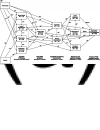Cognitive paths from trauma to posttraumatic stress disorder: a prospective study of Ehlers and Clark's model in survivors of assaults or road traffic collisions
- PMID: 31507261
- PMCID: PMC7557160
- DOI: 10.1017/S0033291719002253
Cognitive paths from trauma to posttraumatic stress disorder: a prospective study of Ehlers and Clark's model in survivors of assaults or road traffic collisions
Abstract
Background: Individual differences in cognitive responses to trauma may represent modifiable risk factors that could allow early identification, targeted early treatment and possibly prevention of chronic posttraumatic stress disorder (PTSD). Ehlers and Clark's cognitive model of PTSD suggests that negative appraisals, disjointed trauma memories, and unhelpful coping strategies maintain PTSD. These are thought to be influenced by cognitive processing during trauma. The aim of this study was to test this model prospectively with path analyses.
Methods: Participants (N = 828) were recruited from an emergency department following injury in a violent assault or road traffic collision and 700 participated in the 6-month assessments. Cognitive processing was assessed shortly after the event, negative appraisals, disjointed memories, and unhelpful coping strategies at 1 month, persistent PTSD symptom severity at 6 months, and early PTSD symptom severity at 2 weeks.
Results: Cognitive variables, with trauma type and gender, explained 52% of the variance in PTSD symptom severity at 6 months. Including early symptom severity in the model did not explain more variance (53%). Early PTSD symptom severity, with trauma type and gender, only predicted 40%. Negative appraisals and disjointed memories predicted persistent symptom severity both directly and indirectly via unhelpful strategies. Peritraumatic processing predicted persistent symptom severity mainly indirectly. The effects of trauma type and gender were fully mediated by the cognitive factors.
Conclusions: The results are consistent with theoretically derived predictions and support cognitive factors as indicators of risk for chronic PTSD and as a target for the treatment and prevention of PTSD.
Keywords: Appraisals; cognitive processing; dissociation; memory; posttraumatic stress disorder; rumination.
Figures


Similar articles
-
Posttraumatic stress disorder following assault: the role of cognitive processing, trauma memory, and appraisals.J Consult Clin Psychol. 2003 Jun;71(3):419-31. doi: 10.1037/0022-006x.71.3.419. J Consult Clin Psychol. 2003. PMID: 12795567
-
Dissociation and post-traumatic stress disorder: two prospective studies of road traffic accident survivors.Br J Psychiatry. 2002 Apr;180:363-8. doi: 10.1192/bjp.180.4.363. Br J Psychiatry. 2002. PMID: 11925361
-
A prospective investigation of the role of cognitive factors in persistent posttraumatic stress disorder (PTSD) after physical or sexual assault.Behav Res Ther. 2001 Sep;39(9):1063-84. doi: 10.1016/s0005-7967(00)00088-7. Behav Res Ther. 2001. PMID: 11520012
-
A systematic review of predictors of posttraumatic stress disorder (PTSD) for adult road traffic crash survivors.Injury. 2013 Nov;44(11):1413-22. doi: 10.1016/j.injury.2013.07.011. Epub 2013 Aug 2. Injury. 2013. PMID: 23916902
-
[Posttraumatic stress disorder (PTSD) as a consequence of the interaction between an individual genetic susceptibility, a traumatogenic event and a social context].Encephale. 2012 Oct;38(5):373-80. doi: 10.1016/j.encep.2011.12.003. Epub 2012 Jan 24. Encephale. 2012. PMID: 23062450 Review. French.
Cited by
-
Psychological, addictive, and health behavior implications of the COVID-19 pandemic.Behav Res Ther. 2020 Nov;134:103715. doi: 10.1016/j.brat.2020.103715. Epub 2020 Aug 27. Behav Res Ther. 2020. PMID: 32891956 Free PMC article. Review. No abstract available.
-
A systematic review of machine learning findings in PTSD and their relationships with theoretical models.Nat Ment Health. 2025 Jan;3(1):139-158. doi: 10.1038/s44220-024-00365-4. Epub 2025 Jan 7. Nat Ment Health. 2025. PMID: 39958521 Free PMC article.
-
Cumulative Trauma Exposure and Post-Traumatic Stress Symptoms among Older Adults in South Africa: Does Post-Traumatic Growth Moderate this Link?J Aggress Maltreat Trauma. 2024;33(10):1212-1227. doi: 10.1080/10926771.2024.2394086. Epub 2024 Aug 23. J Aggress Maltreat Trauma. 2024. PMID: 39430910 Free PMC article.
-
Cognitive processes associated with sudden gains in cognitive therapy for posttraumatic stress disorder in routine care.J Consult Clin Psychol. 2020 May;88(5):455-469. doi: 10.1037/ccp0000488. Epub 2020 Mar 5. J Consult Clin Psychol. 2020. PMID: 32134285 Free PMC article.
-
A temporal network analysis of complex post-traumatic stress disorder and psychosis symptoms.Psychol Med. 2025 Feb 20;55:e43. doi: 10.1017/S0033291725000030. Psychol Med. 2025. PMID: 39973045 Free PMC article.
References
-
- American Psychiatric Association (2000) Diagnostic and Statistical Manual of Mental Disorders: Fourth Edition, DSM-IV-TR. Washington, DC: American Psychiatric Association.
-
- Arbuckle LL (1996) Full information estimation in the presence of incomplete data In Marcoulides GA and Schumacker RE (eds), Advanced Structural Equation Modeling. Mahwah, NJ: Lawrence Erlbaum, pp. 243–277.
-
- Baker SP, O'Neill B, Haddon W and Long WB (1974) The injury severity score: a method for describing patients with multiple injuries and evaluating emergency care. The Journal of Trauma 14, 187–196. - PubMed
-
- Benjet C, Bromet E, Karam EG, Kessler RC, McLaughlin KA, Ruscio AM, Shahly V, Stein DJ, Petukhova M, Hill E, Alonso J, Atwoli L, Bunting B, Bruffaerts R, Caldas-de-Almeida JM, de Girolamo G, Florescu S, Gureje O, Huang Y, Lepine JP, Kawakami N, Kovess-Masfety V, Medina-Mora ME, Navarro-Mateu F, Piazza M, Posada-Villa J, Scott KM, Shalev A, Slade T, ten Have M, Torres Y, Viana MC, Zarkov Z and Koenen KC (2016) The epidemiology of traumatic event exposure worldwide: results from the World Mental Health Survey Consortium. Psychological Medicine 46, 327–343. - PMC - PubMed
-
- Bentler PM (1990) Comparative fit indexes in structural models. Psychological Bulletin 107, 238–246. - PubMed

